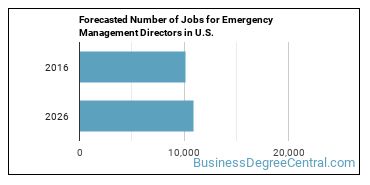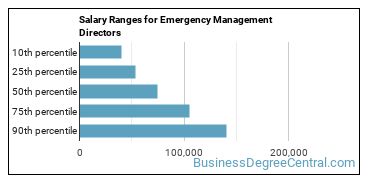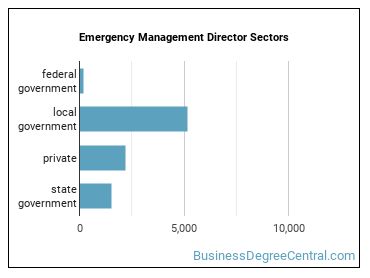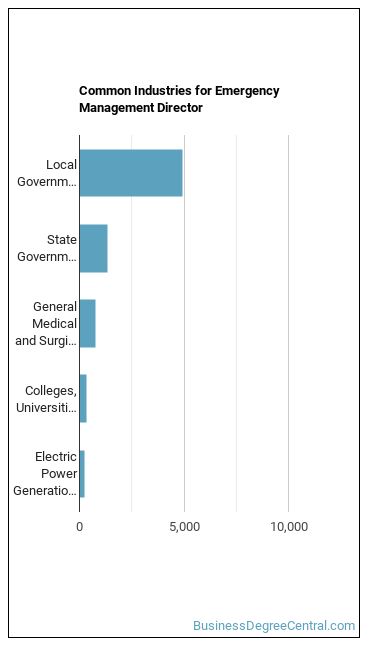What Do Emergency Management Director Do?
Occupation Description Plan and direct disaster response or crisis management activities, provide disaster preparedness training, and prepare emergency plans and procedures for natural (e.g., hurricanes, floods, earthquakes), wartime, or technological (e.g., nuclear power plant emergencies or hazardous materials spills) disasters or hostage situations.
Emergency Management Director Responsibilities
- Inventory and distribute nuclear, biological, and chemical detection and contamination equipment, providing instruction in its maintenance and use.
- Develop and implement training procedures and strategies for radiological protection, detection, and decontamination.
- Train local groups in the preparation of long-term plans that are compatible with federal and state plans.
- Coordinate disaster response or crisis management activities, such as ordering evacuations, opening public shelters, and implementing special needs plans and programs.
- Review emergency plans of individual organizations, such as medical facilities, to ensure their adequacy.
- Study emergency plans used elsewhere to gather information for plan development.
Featured schools near , edit
Qualities of an Emergency Management Director
Below is a list of the skills most Emergency Management Directors say are important on the job.
Complex Problem Solving: Identifying complex problems and reviewing related information to develop and evaluate options and implement solutions.
Service Orientation: Actively looking for ways to help people.
Judgment and Decision Making: Considering the relative costs and benefits of potential actions to choose the most appropriate one.
Speaking: Talking to others to convey information effectively.
Active Listening: Giving full attention to what other people are saying, taking time to understand the points being made, asking questions as appropriate, and not interrupting at inappropriate times.
Critical Thinking: Using logic and reasoning to identify the strengths and weaknesses of alternative solutions, conclusions or approaches to problems.
Other Emergency Management Director Job Titles
- Emergency Services Director
- Hostage Negotiator
- Emergency Management Specialist
- Emergency Management System Director (EMS Director)
- Civil Defense Director
Emergency Management Director Job Outlook
In the United States, there were 10,100 jobs for Emergency Management Director in 2016. New jobs are being produced at a rate of 7.9% which is above the national average. The Bureau of Labor Statistics predicts 800 new jobs for Emergency Management Director by 2026. Due to new job openings and attrition, there will be an average of 900 job openings in this field each year.

The states with the most job growth for Emergency Management Director are Arizona, Utah, and Florida. Watch out if you plan on working in New Jersey, Wyoming, or Wisconsin. These states have the worst job growth for this type of profession.
Do Emergency Management Directors Make A Lot Of Money?
Emergency Management Directors make between $40,460 and $141,130 a year.

Emergency Management Directors who work in District of Columbia, California, or Washington, make the highest salaries.
Below is a list of the median annual salaries for Emergency Management Directors in different U.S. states.
| State | Annual Mean Salary |
|---|---|
| Alabama | $69,060 |
| Alaska | $85,120 |
| Arkansas | $47,680 |
| California | $118,320 |
| Colorado | $87,060 |
| Connecticut | $91,120 |
| District of Columbia | $119,820 |
| Florida | $83,580 |
| Georgia | $73,090 |
| Hawaii | $81,660 |
| Idaho | $86,000 |
| Illinois | $81,830 |
| Indiana | $52,810 |
| Iowa | $69,300 |
| Kansas | $55,780 |
| Kentucky | $50,490 |
| Louisiana | $83,610 |
| Maine | $57,200 |
| Maryland | $104,770 |
| Massachusetts | $92,480 |
| Michigan | $72,500 |
| Minnesota | $84,990 |
| Mississippi | $51,200 |
| Missouri | $63,690 |
| Montana | $52,740 |
| Nebraska | $60,330 |
| New Hampshire | $63,780 |
| New Jersey | $93,410 |
| New Mexico | $95,580 |
| New York | $99,960 |
| North Carolina | $74,600 |
| North Dakota | $69,480 |
| Ohio | $75,530 |
| Oklahoma | $53,660 |
| Oregon | $81,460 |
| Pennsylvania | $69,850 |
| Rhode Island | $86,710 |
| South Carolina | $65,130 |
| South Dakota | $49,760 |
| Tennessee | $87,350 |
| Texas | $89,810 |
| Utah | $60,820 |
| Vermont | $82,210 |
| Virginia | $89,580 |
| Washington | $113,860 |
| West Virginia | $73,390 |
| Wisconsin | $74,140 |
| Wyoming | $57,810 |
Tools & Technologies Used by Emergency Management Directors
Although they’re not necessarily needed for all jobs, the following technologies are used by many Emergency Management Directors:
- Microsoft Excel
- Microsoft Word
- Microsoft Office
- Microsoft PowerPoint
- Web browser software
- Microsoft SharePoint
- Geographic information system GIS software
- Graphics software
- Statistical software
- McAfee
- IBM Lotus Notes
- Desktop publishing software
- Relational database software
- ESRI ArcGIS software
- MapInfo Professional
- SunGard Assurance
How to Become an Emergency Management Director
Learn what Emergency Management Director education requirements there are.

How many years of work experience do I need?

Where Emergency Management Directors Are Employed

The table below shows some of the most common industries where those employed in this career field work.

Related Careers
Those thinking about becoming an Emergency Management Director might also be interested in the following careers:
- First-Line Supervisors of Transportation and Material-Moving Machine and Vehicle Operators
- Morticians, Undertakers, and Funeral Directors
References:
Image Credit: Staff Sgt. Christopher Hubenthal via Public domain
More about our data sources and methodologies.
Featured Schools
You have goals. Southern New Hampshire University can help you get there. Whether you need a bachelor's degree to get into a career or want a master's degree to move up in your current career, SNHU has an online program for you. Find your degree from over 200 online programs.
Visit School
